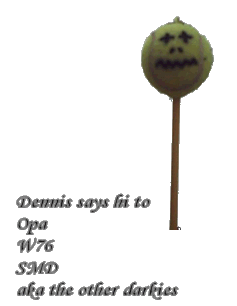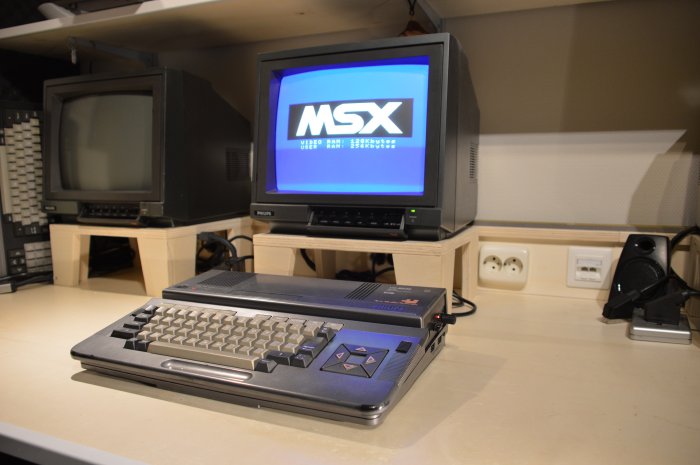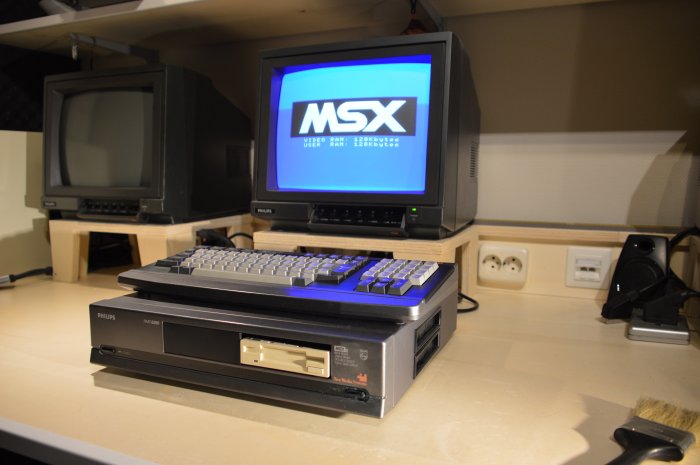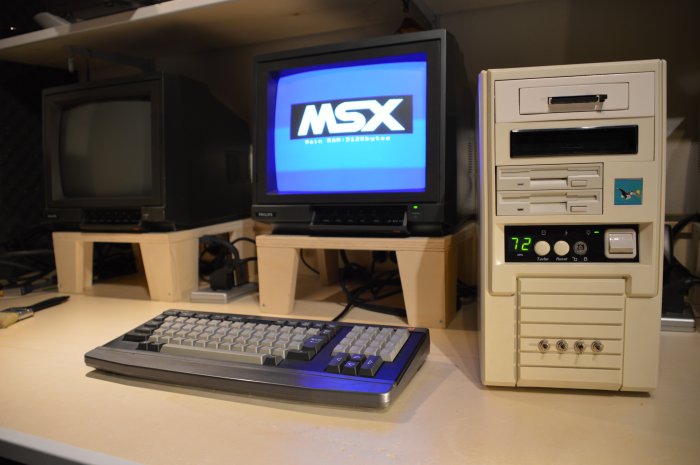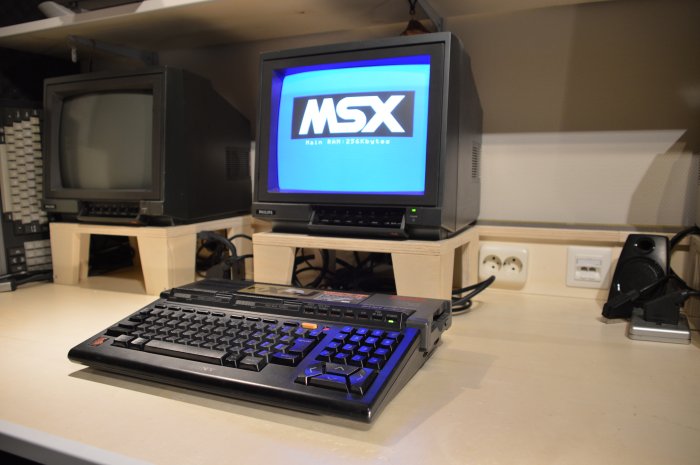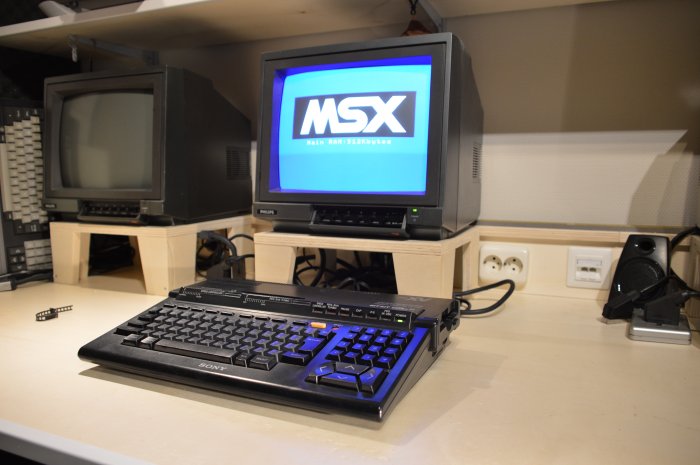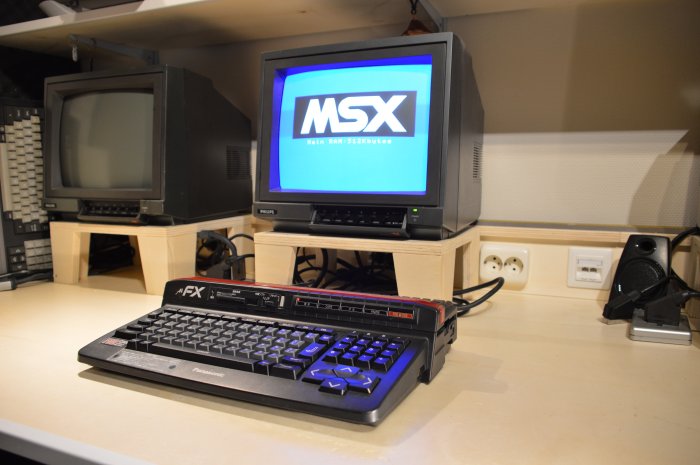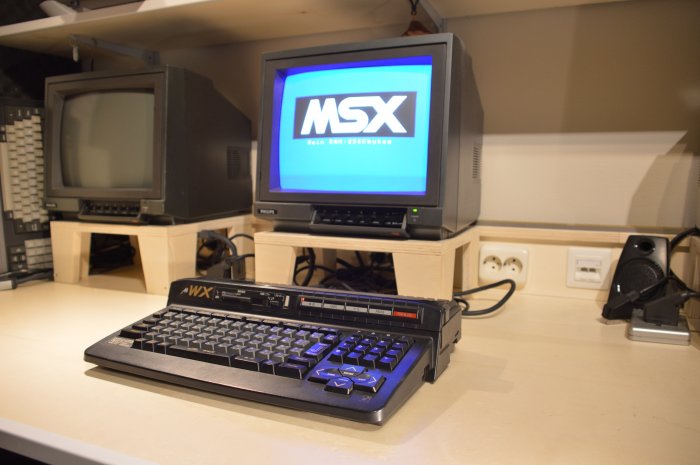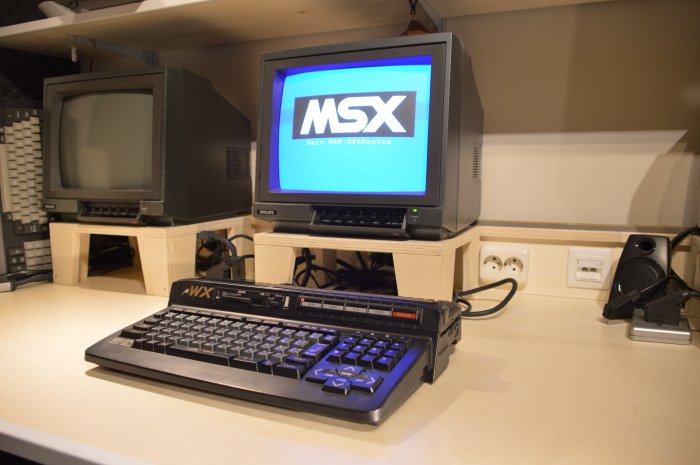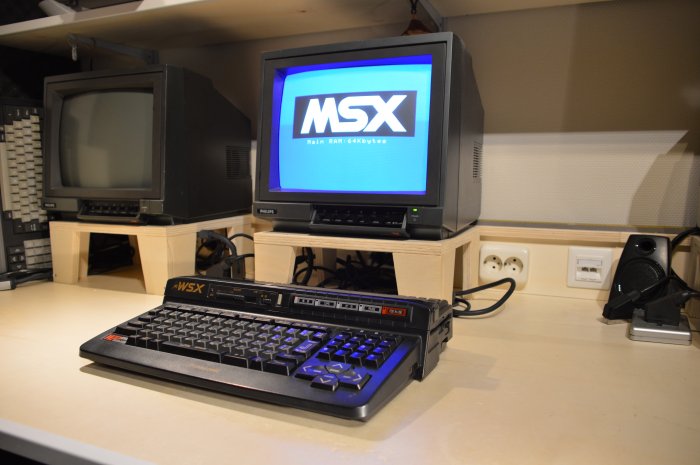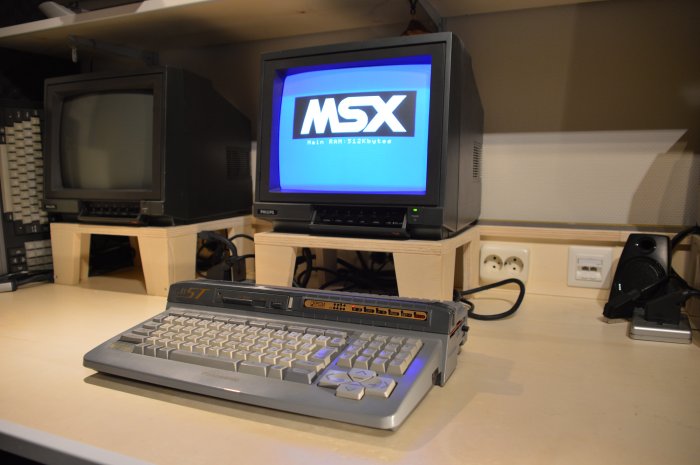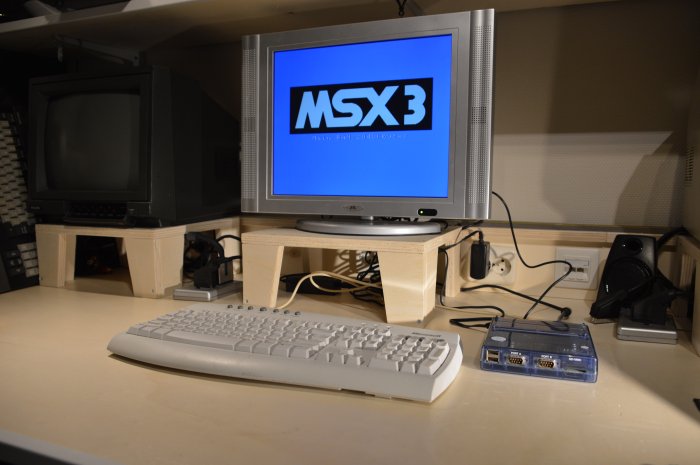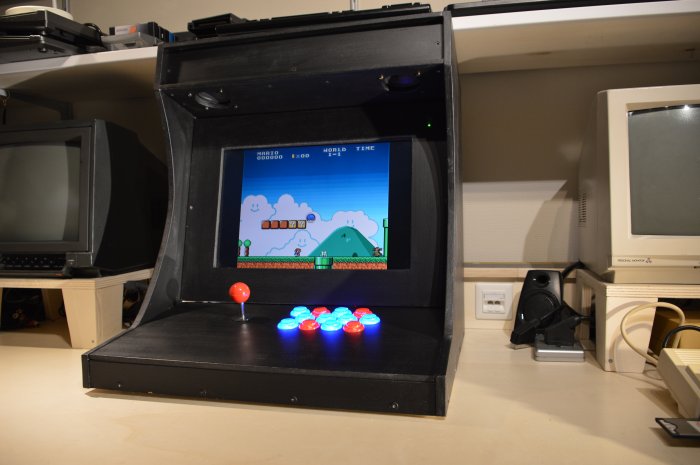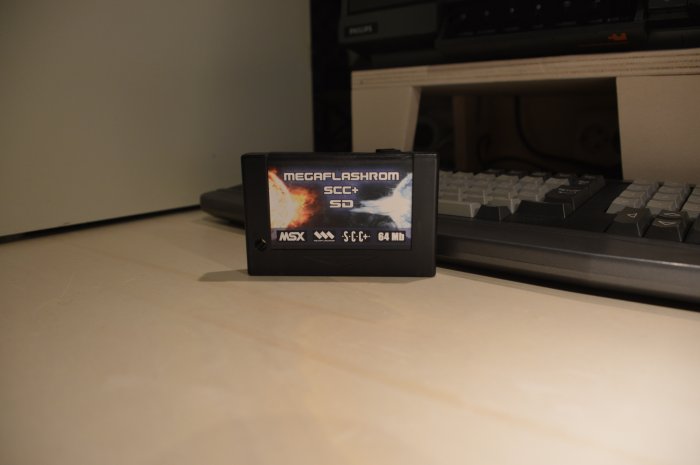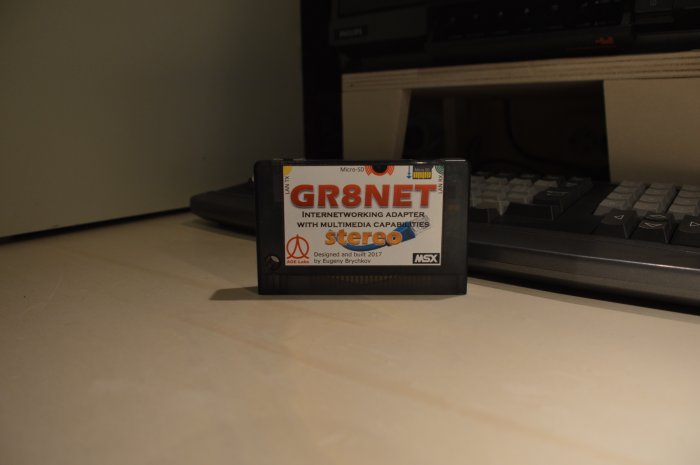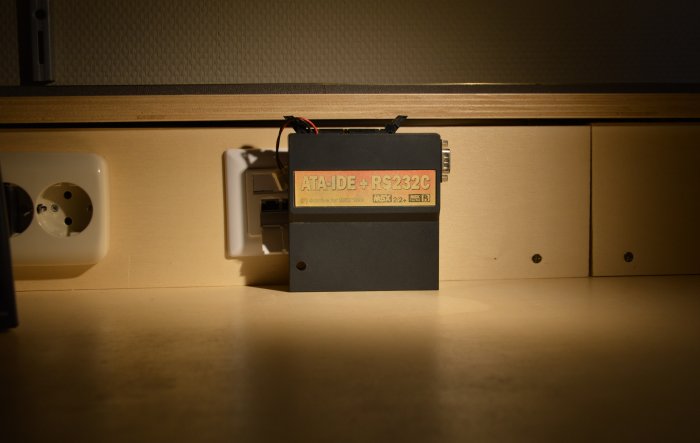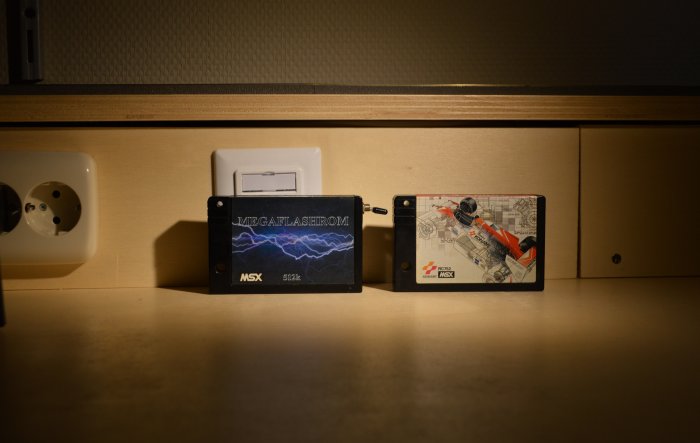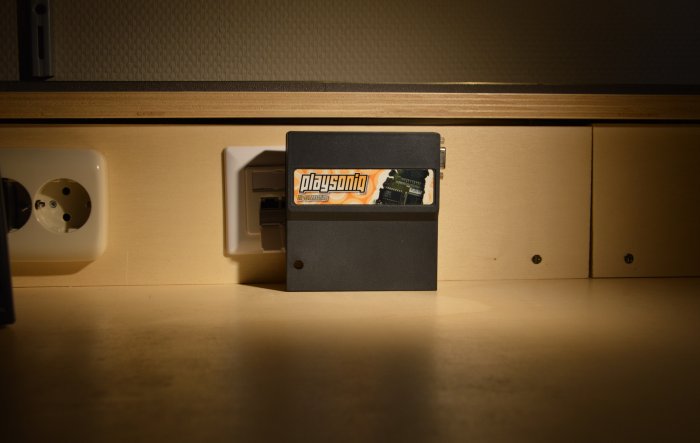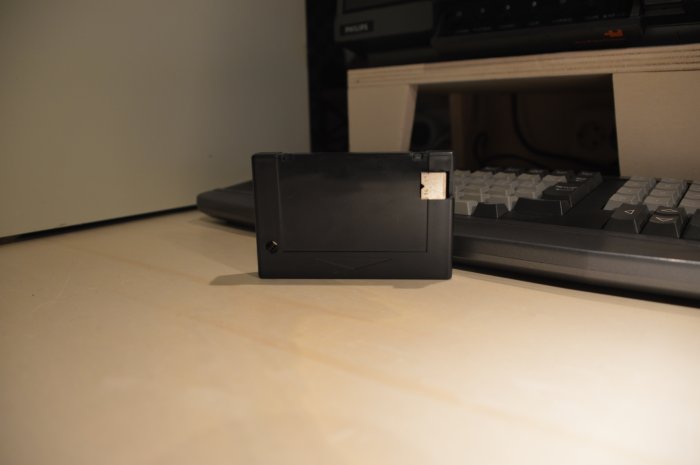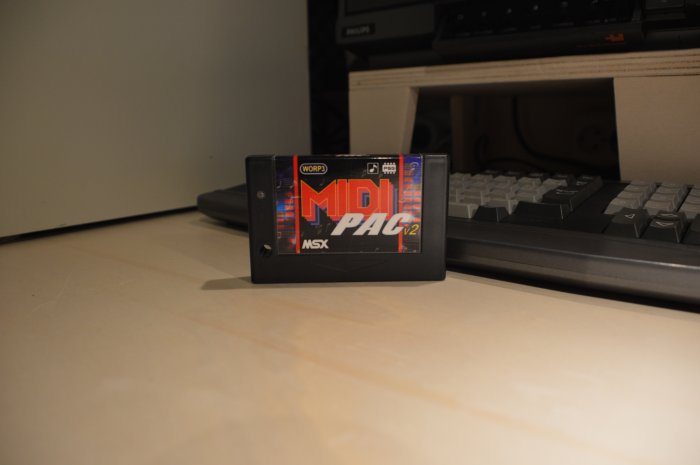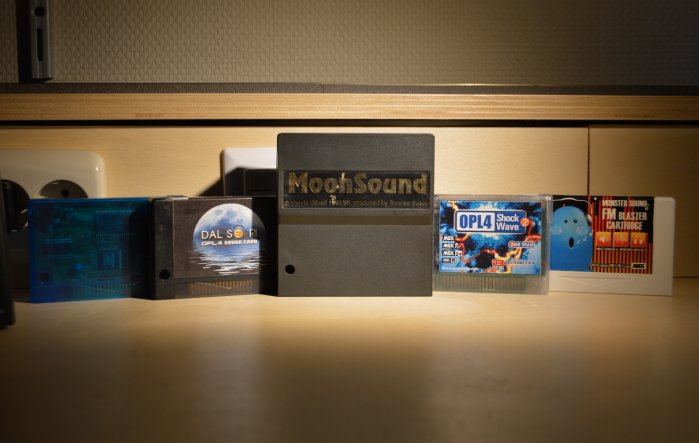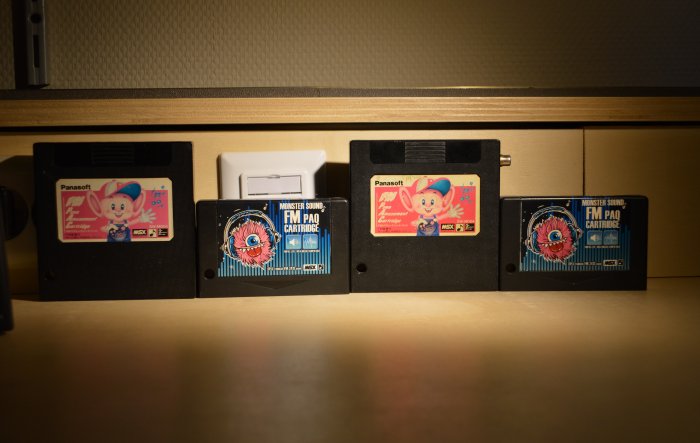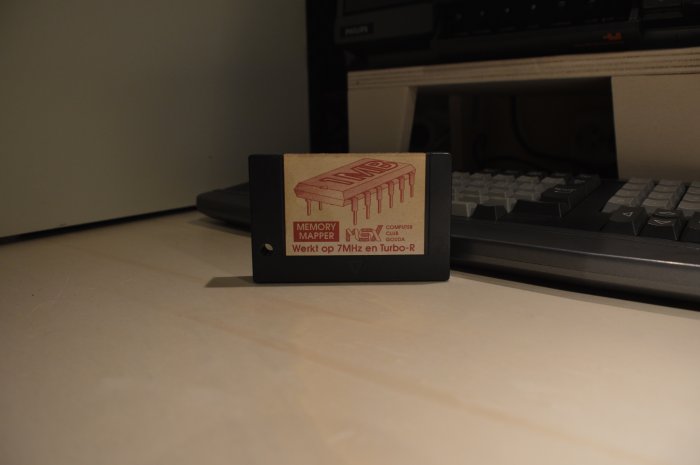EQUIPMENT
Below a summary of my MSX computers and external hardware. The info is taken from the wiki of MSX Resource Center. As most of my hardware has been modded this will be added to the description.
Philips VG 8235/00 MSX2 computer
- Brand: Philips (manufacturer: NEC)
- Type: VG 8235/00
- Year: 1986
- PSU: 220 volt
- Main RAM: 128kB in slot 3-2
- Video RAM: 128kB
- Clock speed: 3.58MHz
- Media: MSX cartridges, 1DD floppy disks
- Video: Yamaha V9938
- Audio: PSG (YM2149 integrated in MSX-Engine S3527)
- Chipset: Yamaha S3527
This unit has some extras:
- Double sided diskROM
- NTSC boot
- Gotek disk emulator with oled/dial
- 256kB main RAM
- RAM counter ROM
Philips NMS 8250 MSX2 computer
- Brand: Philips (manufacturer: Sanyo)
- Type: NMS 8250
- Year: 1987
- PSU: 220 volt
- Main RAM: 128kB in slot 3-2
- Video RAM: 128kB
- Clock speed: 3.58MHz
- Media: MSX cartridges, 2DD floppy disks
- Video: Yamaha V9938
- Audio: PSG (YM2149 integrated in MSX-Engine S3527)
- Chipset: Yamaha S3527
This unit has some extras:
- RAM counter ROM
- 240V PSU fix
- Audio mix fix on cartridgeslots
- Audio fix on analog board
- Fast diskROM 1.08
Philips NMS 8250 MSX2+ computer (Tweety)
- Brand: Philips (manufacturer: Sanyo)
- Type: NMS 8250
- Year: 1987
- PSU: 220 volt
- Main RAM: 128kB in slot 3-2
- Video RAM: 128kB
- Clock speed: 3.58MHz
- Media: MSX cartridges, 2DD floppy disks
- Video: Yamaha V9938
- Audio: PSG (YM2149 integrated in MSX-Engine S3527)
- Chipset: Yamaha S3527
This unit has some extras:
- MSX2+
- KUN Basic
- 512kB main RAM
- 7.16MHz switchable by turbo button
- 3.58MHz/7.16MHz cartridge clock switch on the back of the case
- Audio fix on analog board
- Audio mix fix on the cartridge slots
- Cartridge slot 1 internal, containing:
- A 4+2x I/O slot expander with the RAM slots switchable on the front
- Sunrise GFX9000 1.0 in I/O slot 1 with connector on the back of the case
- Toshiba music module with FRS mod and 256kB sampleRAM in I/O slot 2
- Sunrise ATA-IDE RS232C interface in slot 1-0
- MegaFlashROM SCC 1.0 (512kB flashram) in slot 1-1
- Sunrise Moonsound 2.0 with 1MB SRAM in slot 1-2
- Panasonic FM-PAC with English firmware in slot 1-3
- Cartridge slot 2 in 5.25" bay
- Compact Flash reader in 5.25" bay. Master is internal. Slave is external
- Two 720kB disk drives
- IDE busy LEDs
- Power LED
- Turbo button, reset button, power button
- Per music cartridge two RCA outputs on the back side
Sony HB-F1XDJ MSX2+ computer
- Brand: Sony
- Model: HB-F1XDJ
- Year: 1988
- PSU: 100 volt
- Main RAM: 64kB in slot 3-0
- Video RAM: 128kB
- Clock speed: 3.58MHz
- Media: MSX cartridges, 2DD floppy disks
- Video: Yamaha V9958
- Audio: PSG (YM2149 integrated in MSX-Engine), MSX-Music
- Chipset: Yamaha S1985
- Extras: MSX-Music Basic, 256kB Kanji-ROM JIS level 1 and 2, Speed controller, Ren-Sha turbo (autofire), hardware pause key, Kanji Basic
This unit has some extras:
- A rewired PSU to 220 volts
- 256kB main RAM
Sony HB-F1XV MSX2+ computer
- Brand: Sony
- Model: HB-F1XV
- Year: 1988
- PSU: 100 volt
- Main RAM: 64kB in slot 3-0
- Video RAM: 128kB
- Clock speed: 3.58MHz
- Media: MSX cartridges, 2DD floppy disks
- Video: Yamaha V9958
- Audio: PSG (YM2149 integrated in MSX-Engine), MSX-Music
- Chipset: Yamaha S1985
- Extras: MSX-Music Basic, 256kB Kanji-ROM JIS level 1 and 2, Speed controller, Ren-Sha turbo (autofire), hardware pause key, Kanji Basic
This unit has some extras:
- A new PC disk drive
- Keyboard membrane replaced with PCB
- 512kB main RAM
Panasonic FS-A1FX MSX2+ computer
- Brand: Panasonic
- Type: FS-A1FX
- Year: 1988
- PSU: 100 volt
- Main RAM: 64kB in slot 3-0
- Video RAM: 128kB
- Clock speed: 3.58MHz / 5.37MHz
- Media: MSX cartridges, 2DD floppy disks
- Video: Yamaha V9958
- Audio: PSG (AY-3-8910 compatible, integrated in MSX-Engine T9769x)
- Chipset: Toshiba T9769 model A or B
- CPU: Z80 that can be switched to 3.57MHz or 5.37MHz via I/O ports
- Extras: CPU turbo mode, Cockpit firmware, firmware switch, reset button, pause button, Ren-Sha turbo (autofire), Kaji-ROM level 1, Kanji Basic.
This unit has some extras:
- 512 kB main RAM
- MSX-Music built in
- A PC disk drive
- A 240V PSU
Panasonic FS-A1WX MSX2+ computer
- Brand: Panasonic
- Type: FS-A1WX
- Year: 1988
- PSU: 100 volt
- Main RAM: 64kB in slot 3-0
- Video RAM: 128kB
- Clock speed: 3.58MHz / 5.37MHz
- Media: MSX cartridges, 2DD floppy disks
- Video: Yamaha V9958
- Audio: PSG (AY-3-8910 compatible), MSX-Music
- Chipset: Toshiba T9769 model A or B
- CPU: Z80 that can be switched to 3.57MHz or 5.37MHz via I/O ports
- Extras: Ren-Sha turbo (autofire), hardware pause key, MSX-Music Basic, Kanji-ROM level 1 and 2, firmware (A1 Cockpit, Word Processor, MSX-JE), firmware switch, Kanji Basic.
This unit has some extras:
- 512 kB main RAM
- No floppy disk drive due to a broken controller
- A 240V PSU
Panasonic FS-A1WX MSX2+ computer
- Brand: Panasonic
- Type: FS-A1WX
- Year: 1988
- PSU: 100 volt
- Main RAM: 64kB in slot 3-0
- Video RAM: 128kB
- Clock speed: 3.58MHz / 5.37MHz
- Media: MSX cartridges, 2DD floppy disks
- Video: Yamaha V9958
- Audio: PSG (AY-3-8910 compatible), MSX-Music
- Chipset: Toshiba T9769 model A or B
- CPU: Z80 that can be switched to 3.57MHz or 5.37MHz via I/O ports
- Extras: Ren-Sha turbo (autofire), hardware pause key, MSX-Music Basic, Kanji-ROM level 1 and 2, firmware (A1 Cockpit, Word Processor, MSX-JE), firmware switch, Kanji Basic.
This unit has some extras:
- 512 kB main RAM
- A PC disk drive
- A 240V PSU
Panasonic FS-A1WSX MSX2+ computer
- Brand: Panasonic
- Type: FS-A1WSX
- Year: 1989
- PSU: 100 volt
- Main RAM: 64kB in slot 3-0
- Video RAM: 128kB
- S-RAM: 16kB
- Clock speed: 3.58MHz / 5.37MHz
- Media: MSX cartridges, 2DD floppy disks
- Video: Yamaha V9958
- Audio: PSG (AY-3-8910 compatible), MSX-Music
- Chipset of my unit: Toshiba T9769C
- CPU: Z80 that can be switched to 3.57MHz or 5.37MHz via I/O ports
- Extras: MSX-JE, Ren-Sha turbo (autofire), hardware pause key, MSX-Music Basic, Kanji-ROM level 1 and 2, firmware (A1 Cockpit, Word Processor with support for color printers), firmware switch, Kanji Basic
This unit has some extras:
- 512 kB main RAM
- A PC disk drive
- A 240V PSU
Panasonic FS-A1ST MSX turbo R computer
- Brand: Panasonic
- Type: FS-A1ST
- Year: 1990
- PSU: 100 volt
- Main RAM: 256kB in slot 3-0
- Video RAM: 128kB
- S-RAM: 16kB
- Clock speed: z80: 3.58MHz / r800: 7.16MHz (equivalent to a 28.64MHz z80 CPU)
- Media: MSX cartridges, 2DD floppy disks
- Video: Yamaha V9958
- Audio: PSG (AY-3-8910 compatible), MSX-Music, PCM
- Chipset: Toshiba T9769C and NEC S1990 bus controller
- Extras: Microphone, MSX-JE, firmware switch, MSX-Music Basic, Kanji-ROM level 1 and 2, Pause key, Ren-Sha turbo (autofire), MSX-DOS2, Kanji Basic
This unit has some extras:
- A 240V PSU
- 512 kB main RAM
- A PC disk drive
One Chip MSX
- Brand: ESE
- Type: One Chip MSX (This model is configured as MSX2+)
- Year: 2006
- PSU: 5 volt
- Main RAM: 1MB in slot 3-0 (upgraded to 4MB) (this model is set to 2MB)
- Video RAM: 128kB
- Clock speed: 3,54MHz, 5,37, 10,74MHz
- Media: SD/MMC card, MSX cartridges
- Video: Emulated V9938/V9958 by FPGA
- Audio: Emulated PSG, MSX-Music and SCC by FPGA
- Chipset: Altera Cyclone EP1C12Q240C8N
- Extras: FPGA, USB, VGA, PS/2 connector, Kanji-ROM level 1, MSX-Music Basic, Kanji Basic, X-Basic, MSX-DOS2 with FAT16 support, MEGA-SCSI compatible support for SD card as primary drive.
Bartop
- Brand: Homemade
- Year: 2019-2020
- System: Lenovo Thinkcentre 4th gen I5
- OS: Batocera
Constructed of salvaged pc and laptop parts.
- The MDF wood came from my sister, which was sawn to my design by my dad.
- The Lenovo thinkcentre was lying around doing nothing useful
- The screen comes from a laptop.
- The ATX PSU comes from a crate full of salvaged PSUs.
- The speakers come from an old donated computer speaker set.
- The buttons and joystick were bought from e-bay.
- The controllerboard between Odroid and screen was bought from e-bay.
- On the backpanel are buttons to turn on/off the screen, Odroid and speakers, as well as a 1Gb ethernet port, a USB2 port (for second player controller/keyboard) and a headphone jack.
Sony Playstation 2 slim
- Brand: Sony
- Type: slim
- Year: 2004
This unit has some extras:
- Matrix Infinity hard modded
- Boots games from NAS server through SMB protocol with Open PS2 Loader
Not up to date below here
MegaFlashROM SCC+ SD
- Manufacturer: Manuel Pazos
- Release year: 2013
- Slots: 1 master and 1 slave µSD slot
- Flash ROM: 8 MB
- FAT: FAT16
- Audio: SCC+ / Cloned PSG
- All on FPGA
This unit got enhanced by adding a audio out jack.
Got two of them, just in case.
Gr8net
- Manufacturer: Age Labs
- Release year: 2017 (this model, S/N 6C series)
- stereo 3.5mm jack audio output
- Switch for throughput of audio to MSX on/off
- µSD slot
- RJ-45 Ethernet 10/100Mbit
- FAT16 in Nextor/FAT32 with built in browser
- Audio: SCC+ / MSX-Music / MSX Audio / PCM / MP3
- External RAM: 1024kB
- All on FPGA
This unit got expanded to 16MB
ATA-IDE+RS232C interface
Tweety has this IDE interface by Sunrise built in in order to get life into the Compact Flash reader which is built into its case.
SCC
Two MegaFlashROM SCC cartridges with a 512KB flashROM onboard. Both are housed in a donor Konami cartridge with the real SCC still in function. The one to the left is housed in Tweety
Playsoniq
- Manufacturer: Supersoniqs
- Release year: 2012
- Connector: RGB out+audio
- RAM: Up to 16MB user RAM
- Audio: PSG, SCC+, SID
- Video: Sega Master System
- Can run Sega Master System games. MSX Keyboard/Joystick code gets inserted dynamically.
- Can play PSG over SCC
Padial PS/2 Keyboard interface
Cartridge that can translate PS/2 keyboard input to MSX. Works in most MSX computers. Not all PS/2 keyboards are supported and genuine PS/2 signal must be present
WORP3 MIDI-PAC 2
A cartridge that translates PSG and MSX-Music signals to MIDI data. I use this a lot when I make music on my synthesizers. When used to emulate MSX-Music not all 128GM instruments can be used. The instruments are grouped in as small as possible groups. In this second version of MIDI-PAC WORP3 managed to squeeze more groups in it with more diversity in the instruments as a result. When used with WORP3's command line MID player all instruments are available.
OPL4
In the mid nineties Sunrise developed and produced an OPL4 soundcard for MSX. As the tracker that came with it was written by Moonsoft, the name of the cartridge was Moonsound.
Mine is version 2.0 and has had its shares of dying moments. Just when I started to pick up my MSX activities again when the new millennium had just started, I found out that one side was mute. It turned out that a pre-amp had died. Sunrise replaced both left en right pre-amps for a higher quality version and added 512kB SRAM to its original 128kB. It worked some ten years until the OPL4's wave part totally died. Sunrise replaced the synthesizer and added even more SRAM to reach 1MB.
In the meantime I bought a Korean clone named Dal-So-Ri in case my Moonsound would die. I received it just before my Moonsound did die. What a coincidence.
The third OPL4 cartridge is the white FM Blaster by the French Repro Factory. The name is somewhat unlucky as FM is only a part of the cartridge and there is little to no support for the FM of the OPL4. It is a clone of Wozblaster. This cartridge outputs less volume than the other OPL4 cartridges. Just cranking up the volume of the amplifier is not the most satisfying solution as the noise gets amplified as well. Therefore there's a solution to this problem.
When Junsoft decided to make an update of Dal-So-Ri by adding several new modes, including some MSX-Audio features, I couldn't resist.
The last OPL4 cartridge I added was a Shockwave 2 by Tecnobytes. They claim it has a better DAC than all other cartridges on this photo. Yet it does not have gold plates and pin 49 is connected so noise from the MSX has a way in.
Dal-So-Ri is my favorite
MSX Audio
I have four Philips NMS-1205 Music Modules. There's one with 256kB sampleram and a 7MHz adaption, one with 256kB sampleram, one with a 7MHz adaption and one without any of all that. None of them has the silly software built in anymore. The tiny one in the middle is the Toshiba HX-MU900 which normally comes without ADPCM sample capacities. This one has 256KB of sampleRAM and the whole MSX-Audio BIOS addon by FRS. This MSX-Audio BIOS can not be used since this cartridge is housed in Tweety in an I/O slot of a 4+2 Slot expander
MSX Music
The FM-PAC is an invention of Panasonic. It contains FM and PAC. PAC was a cartridge which has some S-RAM to save game states on. Only for games which support this feature. Later they came with the MSX Music format and put this together with the old PAC in one cartridge, hence FM-PAC in which PAC stands for Pana Amusement Cartridge.
Later Panasonic released MSX2+ and MSX turbo R computers in which they installed the MSX-Music so they halted the production of their FM-PAC. A lot of clones without the S-RAM were manufactured by several hardware builders in the hobby scene.
Out of the box this cartridge does not have its own audio output. One of mine has a custom RCA output on it so the audio can be separated from the audio coming from other cartridges. It has an English patched firmware installed and is built in to Tweety.
I bought two FM-PAQ lites by Eric Boez. One was going to be installed in Tweety (but that never happened) and one was going to be used as MSX-Music replacement in my turbo R. I am absolutely not satisfied with the poor audio quality of this computer. And since Panasonic's FM-PAC is being switched off in machines with MSX-Music built in I had to do with this.
Both FM-PAQ lites received an output decreasing resistor of 33K on R9 to avoid triggering the clipping LED on my mixer. Eric Boez delivers them quite a bit too loud.
MSX Club Gouda 1 Megabyte external memory mapper
An external memory mapper of 1 Megabyte by MSX Club Gouda.
Expanded to 4 Megabyte
MSX Club Gouda Slot expander 5.0
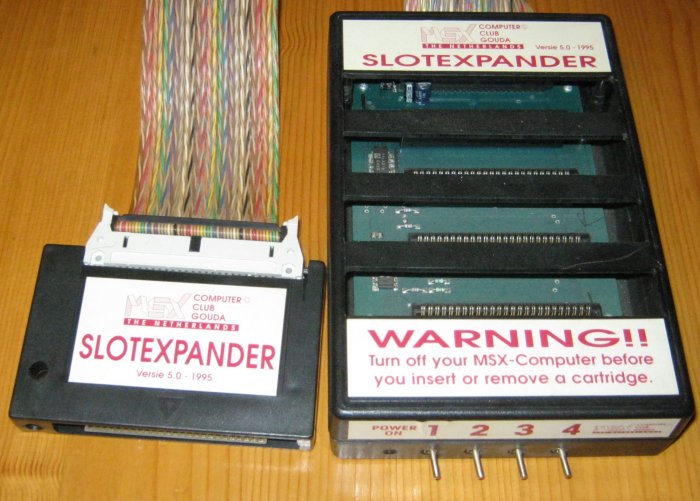
One of the nicest slot expanders around. The MSX Club Gouda slot expander 5.0. it does not need external power, so it is expected that the used MSX has a PSU strong enough to power the filled slot expander.
I got two of them. Just in case.
Stuff to add here
Stuff still to add to this page:
- Philips VG8235/20
- Philips NMS8250 MSX2
- Philips NMS8220
- Sony HB-F700P
- Minime MSX
- Pentium 2
- Playstation 1
- Playstation 3
- Playstation 4 pro
- Intel NUC 7th gen i5 Batocera
- MK Slot Expander 4.0 Clone
- HPN Slot Expander 4+2
- SCCs
- Panasonic MSX-Audio
- Sixpac
- Yamanooto
- Flashjacks
- TNS Addram 4 Megabyte cartridge
- Snatcher Sound Cartridge
- SFG05/01 kloon
- Rookie Drive NX
- Philips/Sony Test Cartridge
- Carnivore 2
- GFX9000 2.0
- Sunrise CF ATA-IDE
- Neotron
The audio rack

In this rack there are several different 19 inch units. From the bottom up the stack consists of the following machines:
- Roland Fantom XR synthesizer with 512MB extra sample RAM.
- Roland JV-1080 with the SR-JV80-13 Vocal expansion board mounted.
- Roland XV-5050.
- Behringer RX-1602 mixer (replaced by a Tascam LM-8ST)
- M-Audio M-Track Eight audio interface.
Synthesizers
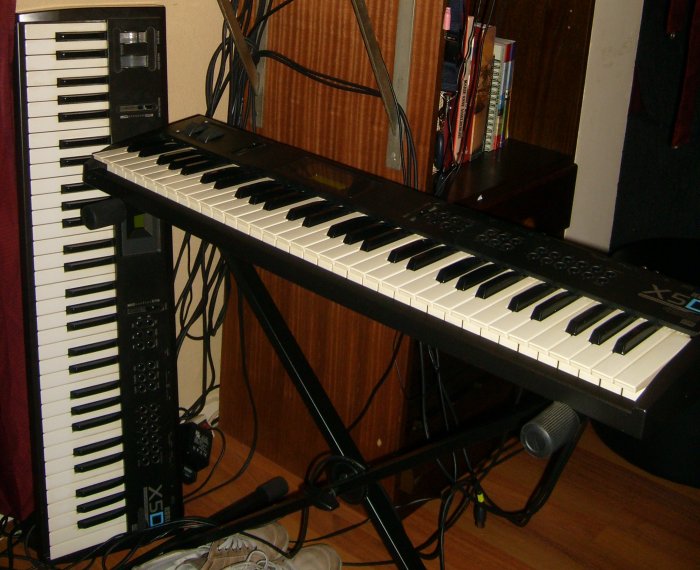
Then there's an old picture of my two Korg X5D synthesizers together. Why two? Well, at the time I just could. I wouldn't want two of them now, but I already have 'em. There are however extra features when having two of them. A Korg X5D is actually just an X5 with some extra samples. These extra samples are being stored in a separate sound bank. Switching between the two is quite a hassle because Korg wasn't really thinking as a user when they made this thing. So when having two, you just have to play the other if you want the other sound bank. Another is that when connecting both synths, you can play more notes simultaneously. One plays the even notes while the other plays the odd notes. Slowly decaying sounds won't be cut off this way.
I only use one of them as a master keyboard while the other is in storage.
The PC
These are modern times. There's a PC involved in this mancave. As of early 2020 I repplaced my old rig for a new one. Here are some specs
- Coolermaster Silencio 550 casing
- Coolermaster 650W 80+ Bronze PSU
- Asus PRIME Z390M-plus main board
- Intel Core i7-9700F processor
- Asus Dual RTX2070 videocard
- Kingston DDR4 2666 32GB HyperX Predator
- Samsung 970 Pro 512GB M.2 PCI NMVe SSD
- Samsung 840 Evo 120GB Sata SSD
- Seagate 3GB bulk drive
- M-Audio M-Track Eight audio interface
- An extra cart reader in the front panel to work with CF carts
- 2x IIyama Prolite E2473HDS main screens
- Windows 11 Pro running tools which aren't too heavy, so in fact the computer is several times overkill to my needs
Work space

This is how the relax corner looked like in the previous house. The new mancave isn't ready yet, so no pics yet.


